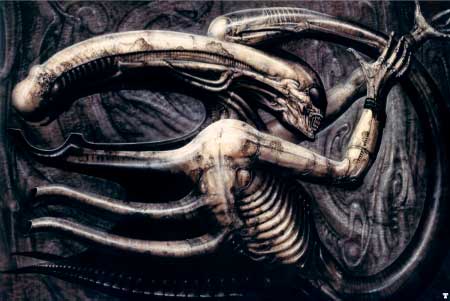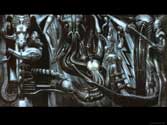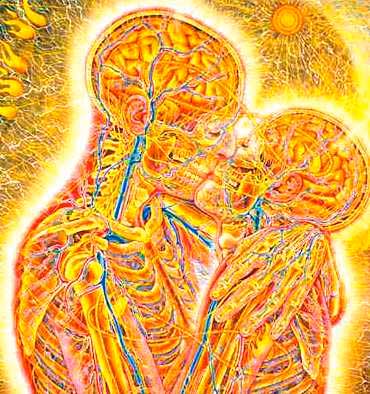
The following is a Research Paper I wrote for an English class during Winter Quarter of this past School year. The pictures are unfortunatly not included but are not completely needed. You should be able to find most of the pictures by looking up both artists.
Two of the most prolific artists alive today are H.R. Giger and Alex Grey. Both artists excelled without formal training in art, creating works that arise from innate personal visions that revel foremost in the creative act itself. Giger and Grey share the main skill of a visionary artist: the ability to listen to the inner voices of the soul and to create expressive works from what they hear, though what they create may not even be thought of as 'art' by the creator (AVAM).

Giger and Grey taught themselves the basics of art at a young age. They each began their career in art with a fresh slate: Grey's father was an artist, but never tried to push his style on him, while Giger's parents had no involvement in art, enabling him to begin in art uninfluenced by any certain style. Once they had begun in art, Giger and Grey both used mind-altering drugs to help them advance in their work, and both found great success in doing so. From there, they both made themselves known to the average consumer by doing CD art. Giger created the cover for Emerson Lake and Palmer's "Brain Salad Surgery" (Appendix A), which was rated one of the 100 best covers in music history in a survey of rock journalists (hrgiger.com). Grey found success with his first cover, Nirvana's "In Utero", which has sold millions of copies worldwide.

Viewing their works side-by-side, it can be noted that Giger and Grey share many inspirations. Both artists convey their ideas about human sexuality in much of their work. Their use of the human figure in their work shows each artist's unique visual style. Both artists use their talents to express their strong views of humanity. Alex Grey and H.R. Giger have both shaken the art world by not only pushing, but also bending the envelope. While both may have similar themes and topics, they convey very different moods and to express their own unique visions and ideas.

Giger and Grey both convey their ideas about the connection between the body and the spirit with their use of sexual imagery, though the ideas they convey are radically different. Giger’s view on sexuality is more in tune with today’s culture and it is evident in almost all of his work. He focuses on the events and changes that occurred in the twentieth century. An important characteristic of the twentieth century is the extraordinary change of attitude toward sexuality, of sexual values, and of sexual behavior. The second half of this century witnessed an unprecedented lifting of sexual repression and polymorphous manifestation of erotic impulses worldwide. On the one hand, it was lifting of cultural constraints leading to sexual freedom and early experimentation of the young generation, premarital sex, promiscuity, popularity of common law and open marriage, gay liberation, and overtly sexual theater plays, television programs, and movies. (Grof Essay)

On the other hand, the shadow sides of sexuality surfaced on an unprecedented scale and became part of modern culture - teenage pregnancy, adult and child pornography, red light districts offering all imaginable forms of prostitution, sadomasochistic parlors, sexual "slave markets," bizarre burlesque shows, and clubs catering to clients with a wide range of erotic aberrations and perversions. And the deepest shadow of them all - the rapidly escalating specter of worldwide AIDS epidemic forged an inseparable link between sexuality and death, Eros and Thanatos.
All of these things have made their way into Giger’s artwork. Such works as “Spell 1” (Appendix B), and “The Necronomicon” (Appendix C) demonstrate these events magnificently. His ability to mix sex with.. Read more
|





